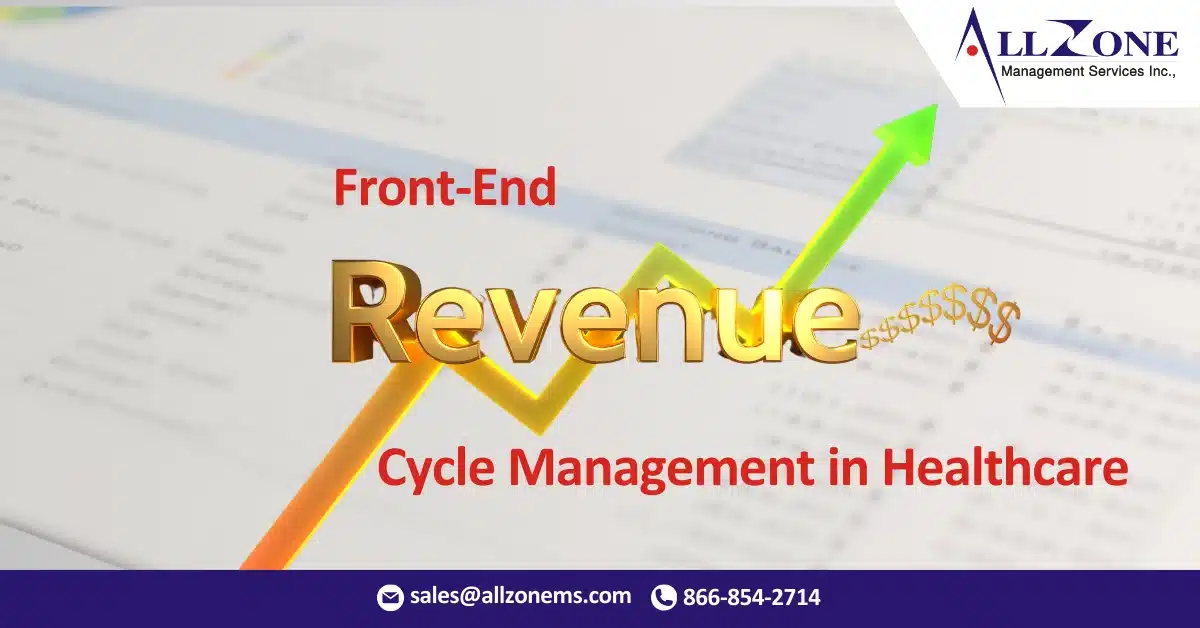The success of a healthcare provider’s financial performance hinges heavily on the efficiency of its front-end revenue cycle management. While the mid and back-end processes, such as coding, billing, and denials management, often receive significant attention, it’s crucial to recognize the profound impact of pre-encounter activities on overall revenue cycle efficiency.
Front-end revenue cycle encompasses tasks like patient scheduling, insurance verification, financial counseling, and upfront collections. These activities are instrumental in ensuring accurate and timely claim generation and revenue capture.
However, healthcare providers frequently encounter challenges in this area. Incomplete or inaccurate patient data can lead to claim errors and delays, while manual processes can hinder overall efficiency.
Front-End Revenue Cycle management Steps:
The front end of healthcare revenue cycle is the initial stage where patient information is collected, insurance is verified, and payments are processed. It’s the foundation for the financial operations of a healthcare facility
Key Components of Front-End Revenue Cycle Management
The front-end revenue cycle in healthcare involves a series of critical steps to ensure accurate patient registration, appointment scheduling, insurance verification, and financial management. This process directly impacts the organization’s revenue and efficiency.
1. Patient Registration:
Gathering comprehensive patient information, including demographics, contact details, insurance coverage, and necessary authorizations.
2. Scheduling and Appointment Management:
Coordinating appointments, managing patient visits, and potentially handling referrals. Effective scheduling ensures timely patient care and accurate billing.
3. Insurance Verification:
Validating insurance coverage and benefits to prevent claim denials and billing complications.
4. Prior Authorization:
Obtaining necessary approvals from insurance providers for specific procedures or treatments.
5. Co-Pay and Deductible Collection:
Collecting patient payments before or after service delivery.
6. Financial Counseling:
Assisting patients in understanding their financial responsibilities, insurance coverage, and payment options. This includes providing cost estimates and promoting price transparency.
7. Patient Access:
While the front-end steps involve direct patient interaction, patient access can encompass a broader range of functions, including care coordination, patient engagement, prescription drug accessibility, and patient education.
Importance of Front-End Processes:
Accurate and timely execution of front-end processes is crucial for ensuring efficient revenue collection, reducing billing errors, and maintaining a consistent revenue stream for healthcare organizations. This contributes significantly to the overall financial health of the institution.
Measuring Front-End Revenue Cycle Management Performance with KPIs
Given the critical role of the front-end revenue cycle in a healthcare organization’s financial health, monitoring its accuracy and efficiency is essential. Key Performance Indicators (KPIs) provide valuable metrics to assess performance.
The Healthcare Financial Management Association (HFMA) has developed a set of specific KPIs for the front-end revenue cycle, known as HFMA MAP Keys. These strategic KPIs offer a benchmark for revenue cycle excellence across different healthcare provider types. They are derived from data collected from financial and monthly revenue cycle reports.
The HFMA MAP Keys identify the following key KPIs for front-end revenue cycle processes:
Key Performance Indicators for Front-End Revenue Cycle Management
To assess the performance of front-end revenue cycle processes, healthcare organizations can use the following Key Performance Indicators (KPIs):
- Percentage of Patient Scheduled Occupied: Measures the utilization of scheduled appointments.
- Pre-registration Rate: Indicates the efficiency of patient access processes.
- Insurance Verification Rate: Assesses the timeliness of insurance verification.
- Service Authorization Rate: Measures the rate of authorizations for inpatient, observation, and outpatient services.
- Conversion Rate of Uninsured Patients to Third-Party Funding: Gauges the success of converting uninsured patients to insurance coverage.
- Point-of-Service Cash Collections: Measures the efficiency of cash collections at the time of service.
Strategies for Front-End Revenue Cycle Management Optimization
To improve front-end revenue cycle performance and reduce claim denials, healthcare organizations should focus on the following strategies:
- Staff Education: Invest in training front-end staff to enhance their knowledge of insurance policies, patient communication, and cost estimation.
- Automation: Implement technology solutions to streamline processes, reduce manual data entry, and improve accuracy. This includes digital pre-registration, patient portals, self-service kiosks, and automated insurance verification tools.
- Digital Payment Options: Offer convenient digital payment options to increase point-of-service cash collections and meet patient expectations.
By prioritizing these strategies and leveraging outsourcing revenue cycle management, healthcare organizations can further enhance their revenue cycle processes. Outsourcing partners provide specialized expertise, access to cutting-edge technology, and scalability, enabling organizations to reduce claim denials, improve cash flow, and focus on delivering high-quality patient care.

